|
Article in the Trading Post Magazine
(July-September 1987)
|
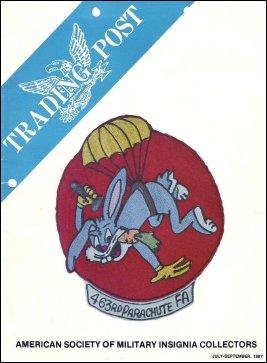 |
The article about the Battalion's
insignia was published in the Trading Post Magazine in the
July-September 1987 issue, and was provided to the webmaster by
Ken Hesler (D/463rd PFA).
We have been granted permission to publish the
article on the website by the ASMIC Adjutant, Mr. Scott Hughes,
on August 12th, 2009. A big thank you to Mr. Hughes,
and Kirk Kellogg, the author.
The website of the ASMIC - American Society of Military
Insignia Collectors can be found at
http://www.asmic.org/
Authorís Note: For the information
and photographs contained in this article, the author is
particularly indebted to the following persons, all of whom are
veterans of the 456th/463rd:
Mr.
William A. Kummerer, Dr. John S. Moore, Mr. Albert J. Toward,
Mr. Kenneth Hesler, Colonel Hugh A. Neal, Colonel John T.
Cooper, Jr., Mr. Joseph W. Lyons, and Mr. Douglas M. Bailey.
Any errors should be ascribed to the author.
|
The 463rd Parachute Field
Artillery Battalion and Its Insignia
KIRK KELLOGG
Background
The 463rd Parachute Field Artillery Battalion was created
on the Anzio beachhead from elements of the 456th Parachute Field
Artillery Battalion. The nucleus of the 456th in turn was made up of men
who had been in the original Parachute Test Battery.
The Parachute Test Battery was activated at Fort Benning, Georgia in the
summer of 1942 and attached to the Parachute School for administration
and training. The mission of the Test Battery was to develop a method
whereby an artillery battery could land with all its weapons and
equipment so that it could immediately go into action in support of
parachute infantry.
The 456th was the Army's first large, regular-functioning airborne
artillery unit, and it was activated on 24 September 1942 at Fort Bragg,
North Carolina as a part of the Airborne Command. The battalion
subsequently provided cadres for the first several artillery parachute
units that were formed at Bragg.
North African and Sicilian Campaigns
The 456th left Fort Bragg in April 1943 as part of the 505th Parachute
Infantry Regimental Combat Team. After a twelve day voyage on the Matson
liner S.S. Monterey, it landed at Casablanca, Morocco and was then moved
by rail to an area near the City of Oujda, on the border with Algeria.
Here the unit continued its training in preparation for the invasion of
Sicily. It was near Oujda that most of the men in the 456th made their
first night jump.
From Oujda the unit was flown to an area near the City of Kairouan in
Tunisia, where it camped in the hot desert for about two days before
boarding C-47s for Operation "Husky." Taking off at around 2100 hours on
the evening of 9 July 1943, the artillerymen arrived over the south
coast of Sicily and jumped soon after midnight. Due to faulty
navigation, high winds, and imparied visibility, almost all of the
airborne units that participated in the initial assault came down far
from their intended drop zones and were widely dispersed. Tragically,
many of the paratroops and glidermen landed in the sea and were drowned.
However, those that did come to ground uninjured coalesced into small
groups and proceeded to roam the enemy rear areas creating havoc and
confusion and leading the Axis High Command to conclude that their
numbers were much larger than they actually were.
After the assault phase of Husky was completed, the 456th was sent to
occupy an area near Trapani at the northwestern tip of the island. It
remained there about one month before higher headquarters decided to
transport the unit back to North Africa. Accordingly, the Air Transport
Command flew Batteries C and D to Bizerte; however, as the result of a
SNAFU the Battalion Headquarters together with A and B Batteries were
landed on the airfield at Comiso near the south coast of Sicily. The
resulting separation was to last about two months. During this time, the
troops at Comiso had the opportunity to engage in direct fire anti-tank
practice by shooting at old vehicles being towed at some length behind a
truck. This practice would later pay big dividends in the snows of
Belgium.
Finally, the elements of the 456th in Sicily were loaded aboard ship and
trans≠ported back to North Africa. After the unit was reunited, it
embarked on a Liberty Ship named the Anson Jones for a voyage to Naples,
Italy. Enroute, the ship put into the Sicilian Port of Syracuse to load
supplies and await nightfall. Passage through the Straits of Messina was
timed to occur after dark in order to minimize the chance of air attack
by German bombers which concentrated on that choke point during daylight
hours.
Italian Campaign
Landing at Naples in mid-December 1943, the 456th marched
to Santa Maria where it was attached to the Canadian≠American First
Special Service Force (FSSF). For the next six months, the history of
the 456th/463rd would be interwoven with that of the "Force." As
expressed by one author and former member of the FSSF, "They were new to
Force then but would in the coming months become as closely attached in
common experience as artillery could manage with infantry."
The 456th joined the FSSF just before its assault on Hill 720, the
western spur of Mt. Sammucro. This assault went in on Christmas Day of
1943 and was part of a general drive toward Cassino and the Gustav Line
during which the role of the FSSF was to protect the right flank of the
U.S. II Corps and secure the high ground covering an attack by the 1st
Armored Division up Highway 6. Enemy resistance east of the Rapido River
and the Gustav Line was largely broken by mid-January 1944.
Fifth Army had issued tentative orders reassigning the FSSF to II Corps
for the impending assault-crossing of the Rapido River. For this
crossing, the 456th was to be attached to the 36th Infantry Division.
However, on the morning of 30 January 1944, both the 456th and the FSSF
were unexpectedly ordered to Pozzuoli, a port staging area near Naples.
At Pozzuoli, they were loaded on LCT's and LCI's, and at dusk they set
sail. Their destination was the Anzio beachhead.
Anzio
Despite a bright moonlight night, enemy aircraft did not molest the
convoy, and at daybreak it was anchored off the headlands of Anzio. By
noon, the units had been unloaded and staged into an open field about
two miles from the town.
On 2 February 1944, the FSSF with the 456th went into the line under VI
Corps. The Corps order read: "First Special Service Force, with 456th
Field Artillery Battalion (less Batteries C and D) attached, will
relieve the 39th Engineer Combat Regiment night 2-3 February and defend
right flank of VI Corps S of (Bridge 5) inclusive." The 39th Engineers
had been in a defensive posture and were glad to turn over the area to
their replacements.
The sector assigned to the Force extended about eight miles along the
Mussolini Canal from Bridge 5 to the sea. This sector comprised about
one fourth of the perimeter of the entire beachhead. However, despite
the very thin spreading of troops - about one every twelve yards - and
the much larger enemy formations arrayed in front of it, the Force and
its supporting elements were a constant headache to the enemy through
their effective fire and aggressive patrolling.
Creation of the 463rd
The 463rd came into being on the Anzio beachhead, and its creation calls
for an explanation.
In the early part of 1944, Ridgeway's 82nd Airborne Division was in
England preparing for the Normandy invasion. At that time, the 82nd had
two glider artillery battalions but no parachute artillery. However, the
504th Parachute Infantry Regiment of the 82nd Airborne Division was
still in Italy and had the 376th and the 456th Parachute Field Artillery
Battalions. Ridgeway managed to have C and D Batteries of the 456th
(together with the battalion's numerical designation) transferred to
England with the 504th. The remainder of the 456th, consisting of its
Headquarters along with A and B Batteries, were designated the 463rd
Parachute Field Artillery Battalion. In order to retain its original
fire power, additional guns were obtained from the 45th Infantry
Division to replace the ones taken by C and D Batteries. These were
incorporated into A and B Batteries.
The 463rd was formally created at 1201 hours en 20
February 1944 at a location near the Mussolini Canal and about one half
mile southeast of the small town of Borgo Bainsizza. Like the 456th, the
463rd was assigned to the Fifth Army and attached to the VI Corps. Major
(later Colonel) Hugh A. Neal, who became Battalion Commander of the
456th about five days after the jump on Sicily, continued as commander
of the 463rd.
The Anzio beachhead lasted four months to the day, and during this time
it was essentially a defensive pocket on flat ground overlooked by two
enemy held mountain masses. All parts of the beachhead were periodically
subjected to enemy fire, and survival required burrowing into the ground
for protection. The planning for the breakout from the Anzio beachhead
called for the VI Corps told rive generally northward through the
Velletri gap onto the Valmontone plain where it would cut Highway 6 to
Rome. The mission of the Force and its supporting elements was to sweep
the corps right flank adjacent to the 3rd Divi≠sion by capturing Mt.
Arrestino and then cutting across the Lepini heights to Artena.
On the morning of 23 May 1944, the breakout commenced, and the 463rd
together with division and corps artillery opened fire in support of the
FSSF attack. The initial thrust was to clear the area to the east of
Cisterna as far as the railroad. During this phase, the 463rd provided
effective support, particularly against a heavy concentration of Tiger
and Panther tanks.
On 25 May, the FSSF quickly secured Mt Arrestino South of Cori whereupon
it was ordered to advance directly upon Artena and leave the eastern
heights to the French. Early on 26 May, the Force including the 463rd
arrived in Cori and in the afternoon continued its advance on Artena
arriving there the following day. Resistance to this point was light.
However, during the night of 27-28 May, the Germans moved in tanks and
flak wagons which began firing up and down the steep streets of Artena.
The 463rd forward observers were well placed and proceeded to engage
targets as fast as they appeared. Covering smoke enabled armor to
accompany the FSSF attack which was slowed by an extremely heavy
concentration of enemy weapons on a narrow front. By evening, a crescent
around Artena had been largely secured, On May 31st, Major Neal, the
463rd Battalion Commander, was seriously wounded by an 88mm shell and
had to be evacuated. He was replaced by Major John T. Cooper who had
been the battalion Executive Officer.
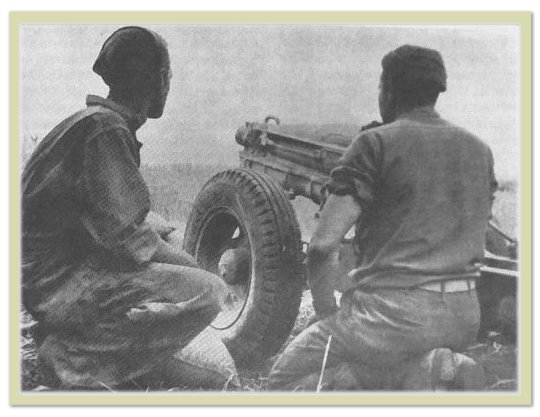
463rd artillerymen near Cori, Italy.
Their "Pack 75" howitzer weighed only 1,268 pounds,
and it could be
disassembled for airdropping.
However, its range with a 75mm projectile was only 9,475 yards
compared
with 12,330 yards
for the Standard howitzer
which fired a 105mm projectile.
Clearing away the resistance around Artena and Valmontone to the north
was not completed until about 2 June and required heavy support from II
Corps. Until the last elements of the German Tenth Army had passed
through Valmontone enroute to Rome and beyond, the enemy resisted the
cutting of Highway 6 with every possible means. During the ensuing
attack on Valmontone by the 3rd Division on 1 June, the FSSF with the
463rd and its other elements had the job of securing the division's
right flank.
Fifth Army was now ready to commence its drive on Rome. With a front
comprised of three corps, it planned to pursue the fleeing enemy through
The Eternal City before he could reorganize on another line. To lead the
assault, II Corps attached Task Force Howze to the FSSF effective 3
June. This Task Force was an armored group comprising elements of the
81st Reconnaissance Battalion and the 13th Armored Infantry under
command of Colonel Howze. It was planned that the FSSF and Task Force
Howze would alternate in the advance, with the armored elements driving
ahead during the day while the FSSF advanced the point at night. With an
enthusiasm akin to gold-rush fever, the units set out at top speed. By
1945 hours on the evening of 3 June, Task Force Howze had advanced
fifteen miles from Valmontone and pulled up to let the FSSF take the
night advance. By midnight the Force had reached Tor Sapienza, a suburb
of Rome. At 0106 hours on 4 June the Force received orders to secure the
six bridges over the Tiber River to the north of Vatican City. The
combined force moved forward at daylight and entered the city limits at
0620 hours, coming under fire almost immediately from antitank guns. It
was 2300 hours that evening before the Force had secured a total of
eight bridges over the Tiber.
In commemoration of their achievement, a plaque was
ceremonially placed on St. Paul's Gate In the middle of Rome on 4 June
1984 - the 40th anniversary of its liberation. The inscription on the
plaque reads as follows:
First
Special Service Force
In Memoriam
On 4 June 1944, the United States-Canadian First Special Service Force
commanded by
Brigadier General Robert T. Frederick
led Allied Forces of General Mark Clark's Fifth Army,
apart of Field
Marshal Sir Harold Alexander's Fifteenth Army Group,
in the attack to liberate The Eternal City. In this action Task Force
Howze of the 1st Armored Division,
the 463d Parachute Field Artillery and city units of the Italian
Resistance gave valiant support
as we breached the gates of Rome and secured the Tiber bridges.
To our brothers in arms of all nations who died in the battles of the
Italian Campaign
we dedicate this memorial.
First Special Service Force Association
4 June 1984
Monte La Defensa - Monte Majo - Monte Sammucro
Anzio Beachhead - Rome
Through 5 June the FSSF, with the 463rd, assembled in the
area of Tor Sapienza. The following day, they were relieved from combat
and placed in Fifth Army reserve for a much needed rest and
recuperation. For this, the units were moved to Lake Albano, about seven
miles southeast of Rome and west of the Alban Hills. Here the Vatican
summer palace overlooked black volcanic beaches which ringed the blue
waters of the lake. Liberal passes into Rome were interspersed with a
program for reequipping and retraining.
The FSSF and the 463rd parted company on 1 July 1944 when the Force was
moved to a training area south of Salerno (the two units were to meet
again in France). The 463rd remained at the lake until 15 July when it
was moved by truck to Lido de Roma where training continued in
preparation for the invasion of Southern France. Batteries C and D of
the 463rd (originally transferred to England during the reorganization
at Anzio) were activated on 21 July 1944.
Southern France
The invasion of Southern France - code named "Operation Dragoon" - was
conceived as a means of putting large quantities of additional men and
material onto the Continent of Europe. It was not felt that these could
effectively be used in Italy, and the Channel ports were already
operating to capacity. This left the South of France, which included the
large Port of Marseilles.
The invasion was to open with an airborne assault by the First Airborne
Task Force commanded by Brigadier General Robert T. Frederick (who
commanded the First Special Service Force until about 23 June).
Frederick organized and trained this composite unit in the amazing time
of less than one month. The Task Force was to be transported in 535 C-47
and C-53 aircraft together with 465 gliders. It was to drop in the
Argens Valley near Le Muy and Draguignan to block roads leading to the
beachhead then attack the town of Frejus near the coast from the rear.
The parachute troops were to jump at first light around 0430 hours and
were to be followed by the gliders beginning around 0930 hours.
The First Airborne Task Force was principally comprised
of the following units:
British 2nd Independent Parachute Brigade
517th Parachute Infantry Regiment
551st and 509 Parachute Infantry Battalions
550th Glider Infantry Battalion
463rd and 460th Parachute Field Artillery Battalions
602nd Glider Pack Howitzer Battalion
On 11 August, the 463rd was trucked to the airport at Grosseto, about
100 miles north of Rome near the coast. Here, together with the 509th
Parachute Infantry Battalion, they loaded aboard C-47 aircraft for the
flight across the Ligurian Sea.
At 0425 hours on 15 August 1944 in scattered clouds and fog, one half of
Headquarters Battery, all of A Battery, plus the 1st and 2nd Platoons of
D Battery jumped in the vicinity of Le Muy, France. As the result of a
navigational error, the other half of the Headquarters Battery, all of B
and C Batteries plus the 3rd and 4th Platoons of D Battery jumped at
0430 hours in the vicinity of St. Tropez. Despite the inadvertent
splitting of the 463rd into two parts, the unit managed to reassemble as
a battalion by 17 August about 31/2 miles southwest on Le Muy. The
Battalion Commander, Major John T. Cooper, fractured his ankle in the
jump on 15 August and was replaced for approximately two months by Major
Stuart M. Seaton, the Battalion Executive Officer. Upon his return from
a hospital in North Africa in mid-October 1944, Major (later Colonel)
Cooper served as Battalion CO of the 463rd until the end of the war.
After its reassembly, the 463rd worked its way up to the coast toward
Nice with the Task Force. On the way, much larger and better equipped
enemy forces were defeated, captured, or dispersed. Near Nice the 463rd
and a glider infantry battalion were transported north into the Maritime
Alps to fight as mountain troops for the next several months. During
this period the men of the 463rd fought the "Champagne Campaign," which
entailed combat with the enemy interspersed with occasional passes to
enjoy the pleasures of the French Riviera just a few miles away.
However, with the onset of winter, the 463rd was replaced by another
parachute field artillery battalion and on 22 October 1944 was withdrawn
from combat and moved by truck back to the south coast.
For a while, the men of the 463rd were able to relax and enjoy life on
the Riviera without the distraction of the war. However, toward the end
of November 1944, the First Airborne Task Force was disbanded, and the
463rd was attached to the 101st Airborne Division for administration and
rations. The 101st was in north central France at Mourmelon-la-Petite,
just to the east of Reims, where it was sent after Operation Market
Garden in Holland. Traveling by truck from the Mediterranean Coast, the
463rd arrived at Camp Mourmelon on 12 December 1944. The weather was
cold and wet. After a short but restful week, all hell broke loose to
the north.
Battle of the Bulge
Late in the day on 17 December 1944, the 463rd was placed on alert as a
result of the German breakthrough in the Ardennes. In mid-afternoon on
the following day, the artillerymen departed by truck from Mourmelon,
France and headed north. As they neared Bastogne the roads became
crowded with retreating soldiers from units that had received the brunt
of the German onslaught.
On the morning of 19 December, after an all night drive, the 463rd
arrived at the temporary headquarters of the 101st Division Artillery on
the road south of Bastogne only to learn that no plans had been made for
positioning the battalion. On his own initiative, the 463rd Battalion
Commander elected to continue on to the Town of Hemroulle, about 1.5
miles northwest of Bastogne. The unit closed into this area at about
1500 hours and set up its Command Post and Fire Direction Center in the
town. On the following day - 20 December 1944 - the Germans cut the
remaining road leading into Bastogne and completed their encirclement.
The 463rd was assigned the mission of providing artillery support to the
327th Glider Infantry Regiment whose sector thinly covered the west and
south borders of the defensive perimeter. Initially, this support was
limited because of extremely heavy fog and low clouds which prevented
the Forward Observers from adjusting indirect fire. However, fire
missions were conducted whenever targets could be. On the 21st, the
Battalion commenced redeployment of howitzers into previously prepared
direct fire positions from which they could defend against tanks. This
was done because of the changing tactical situation and also because
supplies of high explosive ammunition had dwindled to the point where
they insufficient to support heavy indirect fire missions. Fortunately,
the 463rd had some armor piercing ammunition which it had obtained in
Italy. This ammunition had not been listed on unit ammunition reports,
and it was soon to become very useful.
About noon on 23 December, the weather allowed the first
aerial resupply drop flown by 241 C-47 aircraft. It arrived none too
soon. Some guns had no high explosive shells left, and others had only a
half dozen or so. Rations were totally exhausted. The sight of the
colored supply chutes coming down gladdened the hearts of the
paratroopers. At dusk on the 23rd, the Germans launched an attack from
the south in an attempt to break through the 327th Glider Infantry
lines, but this was halted by midnight with heavy losses to the
attackers.
In the pre-dawn hours of 25 December - Christmas Day - the Germans
launched a second all-out attack intended to wipe out the Bastogne
pocket. This time it was out of the northwest and headed straight toward
the 463rd. Eighteen Mk. IV tanks with supporting infantry broke through
the thin defensive line of the 327th Glider Infantry and began to
advance toward Hemroulle. After the initial breakthrough, little
opposition was met, and the German tank infantry team with eleven of the
tanks proceeded several miles to the outskirts of Hemroulle. Evidently
mistaking the town for Bastogne, the tanks and infantry pulled off the
road and halted. Their stopping point was only about 100 yards from
several of the 463rd howitzers which were virtually invisible because of
the darkness combined with a recent light snowfall. Incredibly, the
German column remained in this position for over an hour. The battalion
headquarters had been alerted to the presence of the tanks by an outpost
guard, however, Major Cooper ordered that fire be withheld for as long
as possible. This was done in hopes that the light of dawn would improve
the hit probability and because of a concern that the tanks might, after
all, be American. As the dawn broke, the outline of the German tanks and
their distinctive muzzlebrakes made identification unmistakable. When
the command to fire was given, the ensuing battle lasted approximately
half an hour, and during this time many of the 463rd men fought as
infantry. Eight tanks were knocked out by the howitzer crews and when
one of the others received a hit which injured its commander, it was
captured intact by an artilleryman who hung his undershirt on the tank's
muzzlebrake and drove it back to within the battalion's defensive
perimeter. Two tanks managed to escape the deadly fire of the 463rd but
were destroyed by a rapid deployment armored force dispatched by
Division Headquarters. Of the eighteen tanks which began the assault,
none survived the day.
In the gathering darkness just after 1700 hours on the following day -
26 December - the first elements of Combat Command R of the 4th Armored
Division broke through the German encirclement from the south and
relieved the siege. During the period 19 December to 31 December 1944,
the 463rd fired over a 360 degree sector, expending a total of 7,676
rounds of ammunition on almost every kind of ground target.
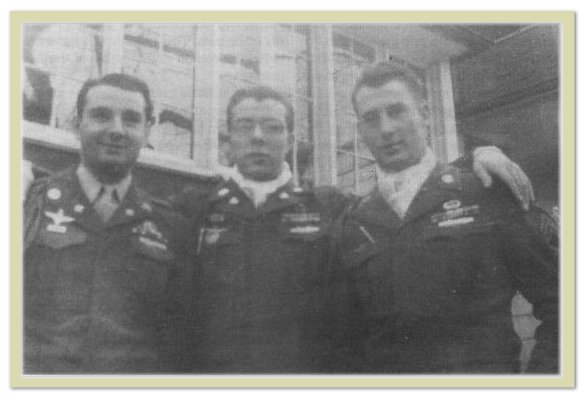
Troopers Richetto, Tower, and Kummerer in a 1945 photo.
Note the Italian jump wings being worn on the left side of the Ike
jackets.
When asked why these wings were worn,
Bud Tower replied "to impress the
girls, what else"
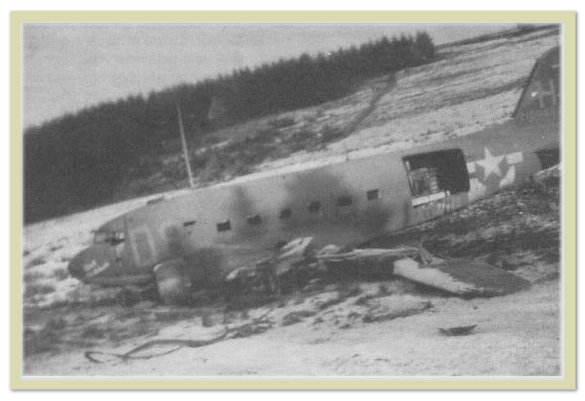
The
victim of anti-aircraft fire, this C-47 crashed in front
of the 463rd
positions at Bastogne.
Before it touched down, its tailwheel is said to have
caught a 2 1/2 ton
truck and spun it around.
The driver of the truck emerged at a full run.
Epilogue
After Bastogne, the 463rd returned to Mourmelon, France, with the 101st
Airborne Division. It was there that orders were received transferring
the 463rd to the 17th Airborne Division for the planned jump across the
Rhine River. However, Major General Maxwell Taylor interceded to have
the 463rd remain with the 101st, and it did so for the rest of the war,
including the Rhineland Campaign. Their line of advance passed through
Liege and Aachen to the Rhine River and then up the of, bank toward
Frankfurt. On VE Day, they were camped in some hills about 30 miles from
Munich.
The 463rd was inactivated on 30 November 1945 in Germany,
but its history was not to end there. On 18 June 1948 it was
redesignated (less Battery D) as the 516th Airborne Field Artillery
Battalion, an element of the 101st Airborne Division (Battery D was
concurrently converted and redesignated as Company K, 506th Airborne
Infantry). On 6 July 1948 it was activated at Camp Breckinridge,
Kentucky and allotted to the Regular Army. Thereafter, its history was
as follows:
-Inactivated 29 April 1949 at Camp Breckinridge, Kentucky
-Activated 25 August 1950 at Camp Breckinridge, Kentucky
-Inactivated 1 December 1953 at Camp Breckinridge, Kentucky
-Activated 15 May 1954 at Fort Jackson, South Carolina
-Redesignated 1 July 1956 as the 463rd Airborne Field Artillery Bn.
Inactivated 25 April 1957 at Fort Campbell, Kentucky
The Insignia
The 463rd Parachute Field Artillery Battalion is not generally thought
to have had any cloth insignia, however, two quite different patches
were designed and actually made during World War II, and one of them was
"formally" adopted - albeit many years later by veterans of the unit.
One of the two patches featured a howitzer under a parachute canopy and
was intended to be worn on the shoulder. The other was a large and
colorful jacket patch featuring Bugs Bunny under a parachute canopy, and
it had the unit designation on an integral tab at the bottom. Very few
of these patches were made, and the originals are extremely rare.
The above patches were conceived by members of the 463rd
after the breakup of the 456th on 20 February 1944.
Understandably, the breakup was not well received by the
men of the unit, and one of the commanding officers later referred to it
as "the rape of a battalion" The 463rd came to think of itself as a
"bastard" unit, and there was evidently a feeling that something was
needed to give it an identity of its own. This thought is what motivated
the design and creation of the two patches.
There is some evidence that the idea of a separate patch for the 463rd
was viewed with disdain by a few of the troopers who had been with the
456th from its early days. They still considered the 463rd -
particularly C and D Batteries to be a Johnny-come-lately outfit. The
Battle of the Bulge largely abolished such divisiveness.
The Howitzer Patch
The design of this patch is straight-forward and almost elegant in its
simplicity. One glance leaves no doubt as to what kind of unit it
represents. The design was conceived by the battalion surgeon, Dr. John
S. Moore, while he was an the Anzio beachhead.
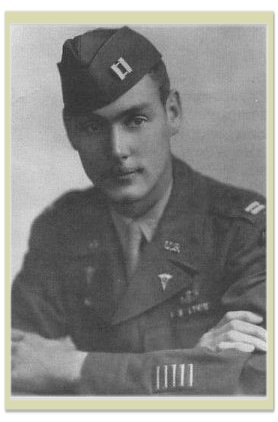
Dr. John S. Moore in a
1945 portrait.
By this time, the 463rd
Parachute Field Artillery was wearing the 101st Airborne Division patch.
After Anzio, he mailed a rough sketch to his parents who
lived In Washington, D.C. The following are excerpts from letters Dr.
Moore wrote to his parents (their responses were not preserved):
23 July 1944: "Do you know of some company in the States
which makes insignias, patches? We have been thinking up a patch to wear
on our sleeves. The 82nd Div. insignia, which we used to wear, was
removed after leaving the Div.
Most other divisions and separate units, like ours, have their own
patches. We would have to design one and get it approved by the War
Dept. which would probably take 6 months. However, we might be able to
get one made up in the meantime. If you know of a company, or could
locate one, that would be fine. The design will probably have a small
field-piece suspended beneath a parachute - the parachute white, the gun
yellow, and background red. Red and yellow are artillery colors" (this
letter evidently enclosed a sketch.)
October 1944. "Thanks for getting (a family friend) to go to so much
trouble. The drawings came the other day, but were not quite what we had
in mind. I am enclosing a rough, color diagram. The view is head-on and
resembles our howitzer. Of course, it never dropped as such, but the
officers seem to like it this way rather than just the tube. The
parachute could, perhaps, be a bit larger. The suspension lines would be
better if white instead of black as I have them. The red background is
too dull a red. It should be a brighter red. The yellow of the cannon
should be more of a golden yellow. The border of black around the cannon
is there for contrast. The black border around the whole should be about
as wide as I tried to make it. The whole design may seem a bit large but
it is just about the size we want it. They seem to think it better
without the number. If you could get (the same family friend) to improve
on this and touch it up, fine. We made it as simple as possible, partly
because we want it simple and partly because it would be easier to run
off. Chances are we may never get a chance to have it approved or wear
it, though; we have been shifted around so much of late."
28 October 1944: "(Your) letter contained the patch that
Father has made up. I have not as yet had a chance to show it to the
officers but will do so later. They have already expressed more interest
in the other design, however, which you may have received by now."
20 November 1944; "Here is one of (family friend's)
designs that I am returning. I have modified it a bit. The lines should
be white, and not black as I have drawn them, but they should not come
to central knot. I made the wheels a bit larger, and the shoulders a bit
more square. The background should be a deep red and the piece a golden
yellow. The ink lines I put on the 'chute are meant to represent the way
the white threads should run. There are four panels, with what would
look like a sort of part between them, as a part on a head of hair. That
is the way that most of the parachute patterns are made. (My sister's)
design was kept here because they want to get official approval on it."
17 December 1944: "About the insignia: I hope you had one of the new
type made up as I would like to see it. However, we are attached to
another unit, and if we wear any it will probably have to be theirs.
Please have one made up, however. There should be no black outlining the
parachute and no black along the suspension lines either."
28 February 1945: "Father's two letters containing the patches arrived
last week. I turned one of them over to the battalion commander and kept
one for myself. They are fine but we will not wear them because the unit
to which we are assigned has its own insignia, which we have to wear."
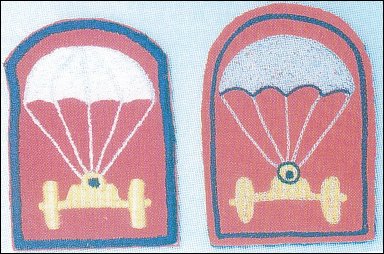
Two
steps in the evolution o1 the shoulder patch conceived by Dr. John S.
Moore.
The final design is on the right.
The construction of these patches is
quite different,
suggesting that they were made by different manufacturers.
From the above correspondence, it would appear that one
of the suggested designs incorporated the battalion number. The patches
which are pictured herein are those which Dr. Moore received from his
father on 28 October 1944 and 28 February 1945. It is thought that only
one or two of each of these were manufactured. They are very different
in construction and were probably produced as samples by different
manufacturers. Dr. Moore believes that his father had them made by a
firm or firms in the Washington, D.C. area.
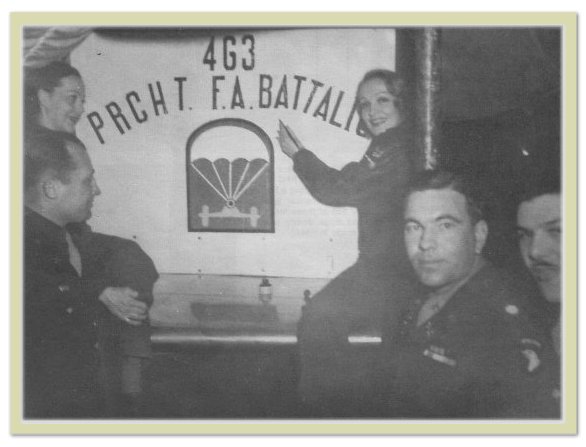
The
officers club (a medical tent draped with parachute canopies)
at Mourmelon, France, after the Battle of the Bulge.
A party was given
in celebration of a visit
by movie actress Marlene Dietrich, seen here signing her autograph.
Second from the right is Major John T. Cooper, CO of the 463rd.
The Bugs Bunny Patch
The large colorful Bugs Bunny patch was the joint
creation of two men, Sergeant William A. Kummerer and PFC Albert J.
"Bud" Towar (rhymes with power). These men were assigned to D Battery,
and shared the same foxhole in the Maritime Alps. During several
discussions, they agreed upon the desirability of a patch and considered
a number of different possible themes. Finally, they decided upon Bugs
Bunny because, despite the indomitable hare's penchant for getting into
trouble, he always managed to get out of it: and they were personally
committed to having the 463rd and themselves endowed with the same
ability! In a letter Bud Towar wrote to Bill Kummerer, dated 18 June
1982, he referred to this aspect of their idea by writing: " .. but
still think the 'Bugs Bunny' patch is indicative of the 463rd - even to
this day he has never lost a battle. If you recall, we picked him for
that reason! In all his cartoons, he always starts out in serious
trouble, but he always comes out of it the winner!"
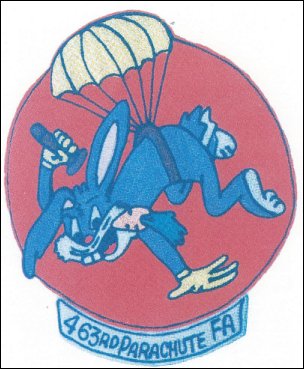
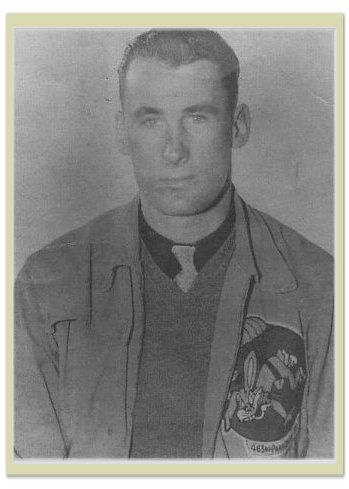
Designed by Sergeant W. A. Kummerer and PFC A. J. Towar
while sharing a
foxhole in Southern France,
approximately 100 of these large
and colorful Bugs Bunny patches were
made in 1944.
Kummerer and Towar made a crude sketch of their patch and
mailed it to Towar's mother, Mrs. Mackie D. Towar, who lived in Grosse
Pointe, Michigan.
Mrs. Towar forwarded the sketch to Warner Bros. in Hollywood where it
was placed in the hands of Mr. Friz Freleng (Freleng was one of several
people who originally created the cartoon character of Bugs Bunny). With
the deft touch of a professional, Freleng finalized the design and sent
an artist's rendering to Mrs. Towar. She then took the drawing to the
Webber Knitting Mills located on Gratiot Avenue near 14th Street in
Detroit and had approximately one hundred patches manufactured. These
were put in a box and mailed to PFC Towar, reaching him about one week
before the Ardennes offensive. Towar was not expecting the patches and
initially thought that the box contained a cake. The patches were passed
out, primarily to the men in D Battery, but also to others in the
battalion who wanted them (it was always intended that the patch
represent the entire battalion and not just D Battery). The ensuring
German offensive in the Ardennes diverted attention from the patch, as
well as all other extraneous things.
It is certain that the howitzer design was never worn as
a patch. However, it was painted on a large board which was used as a
decoration in the battalion officer's club. Some of the Bugs Bunny
patches were sewn on field clothing. In a note to the author, Bud Toward
wrote: "Although I am unable to find a picture of anyone actually
wearing 'Bugs' during the war, I remember sewing one on my field jacket
at Mourmelon. I also remember a direct order ... (through channels)...
to remove it instantly! I remember not doing so at once, and perhaps
that was one reason, out of many others, that I remained a PFC." In
another recollection, it was mentioned that the Bugs Bunny patches were
a little too large for the pockets of either the jump jacket or the
newer field jacket. However, while the 463rd was attached to the FSSF,
General Frederick arranged for the artillerymen to receive the same
special clothing that the Forcemen were issued. Some of the FSSF parkas
were still being worn in France, and these provided a larger area over
the chest on which the patches could be sewn.
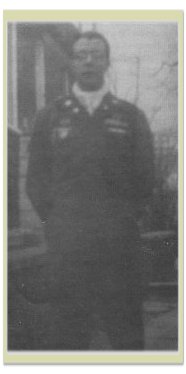
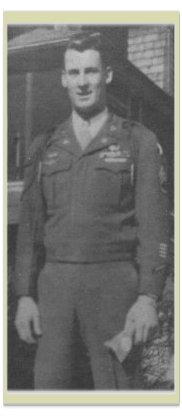
Back
home in 1945. On the left is Bud Towar; on the right is Bill Kummerer.
These men designed the Bugs Bunny patch.
There is an epilogue to the Bugs Bunny patch
story. In 1982, almost forty years after the end of World War II, the
question of an "official" insignia was put to the members of the 463rd
Veterans' Association. The matter was addressed in their newsletter and
in the Static Line newspaper column, and various ideas were suggested.
Finally, at the Chicago Convention held in August 1982, a vote was
taken, and Bugs Bunny won. A letter was written to Warner Bros. Inc.,
requesting permission to use the design, and Warner formally authorized
it in a Copyright License Agreement. Small enameled pins and
reproduction patches (reduced in size and differing in details) have
since been made up, and the design is utilized by the Association in
other appropriate ways.
Distinctive Insignia
Neither the 456th nor the 463rd had a distinctive insignia during
World War II. Later, however, in a Quartermaster Activities letter dated
18 July 1956, submitted through the Commanding General of Third Army to
the Commanding Officer of the 463rd at Fort Campbell, Kentucky, it was
advised that the coat of arms originally approved for the 516th Airborne
Field Artillery Bn, was redesignated for the 463rd Airborne Field
Artillery Bn. The blazonry and description were given as follows:
SHIELD: Gules, in pale a winged cannon barrel muzzle to
base or, each wing charged with three gunstones, in chief on a bezant, a
fleur-de-lis azure.
CREST: None.
MOTTO: Satis Superque (Enough and More)
DESCRIPTION: The colors red and yellow are used for Artillery. The
winged cannon barrel - muzzle to "earth" - suggests artillery from the
"skies" and alludes to the airborne nature of the organization. The six
gunstones represent six battle honors awarded the unit for service
during World War II; the yellow disc and fleur-de-lis for service in
Europe, also referring to the battalion's two decorations, the
fleur-de-lis being blue for the Distinguished Unit Citation.
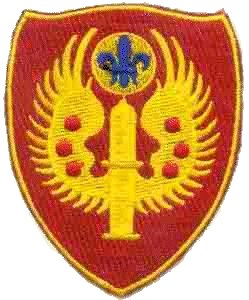
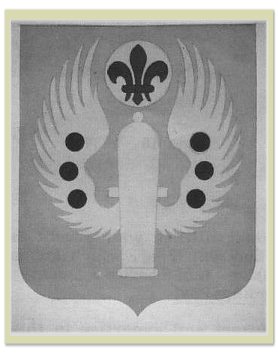
Originally approved
for the 516th Airborne Field Artillery Battalion,
this coat of arms was redesignated for the 463rd in 1956.
Its basic colors are red and yellow. It was worn as a DI.
The record further indicates that samples of the
distinctive insignia were approved by letter dated 26 May 1955, and the
insignia was manufactured by N. S. Meyer, Inc. in New York City.
For the information and photographs contained in this
article, the author is particularly indebted to the following persons,
all of whom are veterans of the 456th/463rd: Mr. William A. Kummerer,
Dr. John S. Moore, Mr. Albert J. Toward, Mr. Kenneth Hesler, Colonel
Hugh A. Neal, Colonel John T. Cooper, Jr., Mr. Joseph W. Lyons, and Mr.
Douglas M. Bailey. Any errors should be ascribed to the author.
|












